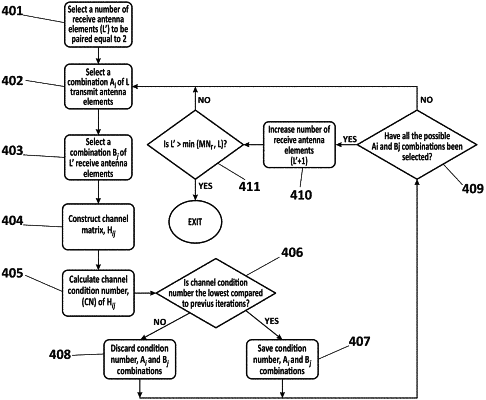| CPC H04B 7/0452 (2013.01) [H04B 7/0686 (2013.01); H04L 25/03898 (2013.01)] | 15 Claims |

|
1. A method to optimize the performance of a MU-MIMO wireless communications system, said wireless communications system comprising at least a base station, with at least one sector having P subsectors with Nt transmit antenna elements each, and M user devices with Nr receive antenna elements each, being L the maximum number of transmit antenna elements which the base station can simultaneously control at baseband processing level, wherein the method comprises the following steps:
a0) setting the number of receive antenna elements to be selected, L′, to a pre-established initial value higher or equal to 2; and going to step a1)
a1) selecting a combination Ai of L transmit antenna elements from the PNt transmit antenna elements and selecting a combination Bj of L′ receive antenna elements from the MNr receive antenna elements; and going to step a2);
a2) calculating the channel condition number of a channel matrix between the L transmit antenna elements contained in Ai and the L′ receive antenna elements contained in Bj; and going to step a3);
a3) if the channel condition number calculated in step a2) is lower than a recorded lowest channel condition number or if there is no recorded lowest channel condition number, recording the value of the calculated channel condition number as the lowest channel condition number and recording actual combinations of transmit antenna elements and receive antenna elements, Ai and Bj respectively, as the optimum combinations of transmit and receive antenna elements; and going to step a4);
a4) if all possible combinations of transmit antenna elements and receive antenna elements (Ai, Bj) have been selected, going to step b), otherwise going to step a1);
b) increasing L′ by one; if L′>min(MNr, L), ending the method, otherwise going to step a1).
|